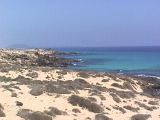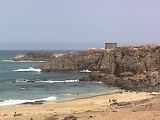|
Deze pagina is verplaatst naar: www.zibkip.be...... This page has moved to: www.zibkip.be...... |
![]()
What to see
Sorry, this page isn't finished yet
About
Fuerteventura Corralejo El Cotillo
La Oliva Tindaya
Tefía
Puerto del Rosario
Antigua Betancuria
Caleta de Fustes Ajuy Pájara
Gran Tarajal La Lajita La
Pared Costa Calma Jandía
Morro Jable Cofete
Fuerteventura is the second largest of the seven Canary Islands. Africa is only 100 km away. The island is 100 km long and from 5 to 30 km wide. There are about 40000 inhabitants, together with thousands of tourists and Spaniards from the mainland who come to work here in the hotel and catering industry.
Although the Canary Islands all have a volcanic origin, they each have their own identity. Many people don't like Fuerteventura, they think it's ugly, and uninteresting. Well, I don't agree. Its beauty lies in the bare, lonely vastness, and in the many shades of the volcanic soil. The mountains (at most 900 meters high), show beautiful colors, from yellow ochre, red, brown to black. There hardly grown anything on the hard soil, here and there some palm trees, succulents and cactuses. However, each part of the island although always barren looks different. It's great for people who love moonlike environments. In the inland, there are only some small villages where there isn't very much to see.
Fuerteventura is especially known for its beautiful, lonely white beaches and dunes. If you like forests, lush vegetation, museums and cultural activities, big cities, or extravagant nightlife, you'd better know that you won't find any of those things on Fuerteventura. When you like beautiful beaches, volcanic areas or if you are more of a sportive type who likes diving and surfing, you'll probably love the island.
Fuerteventura is rather small, so you'll need no longer than a few days or a week to explore it. From the one end of the island (Morro Jable in the south) to the north (Corralejo), is a 135 km drive (it takes about two hours by car over the main road). Don't underestimate distances when you're driving on mountain roads or unpaved roads, where you are forced to drive very slowly.
Map Fuerteventura, Map Canary Islands
What to see
I'll start my description in the north of the island and will end in the south.
Corralejo is a popular seaside resort in the north of the island. There are 3500 inhabitants, and a large number of tourists especially Germans, Britons and Spaniards. The Avenida Generalísimo is the lively main street where are most shops ( souvenirs, electronics, supermarkets, sportswear), restaurants, bars, car rental companies and some hotels). Corralejo has an older, typical Spanish quarter and a new area. There is a short promenade, a small harbor and good beaches. It's not a very beautiful village, but the atmosphere is nice and relaxed. In Corralejo you have a view on the island Los Lobos, which is only two kilometres away. You can go on an excursions to Los Lobos, but I doubt if there is much to see.
![]() Tourist office at Plaza Pública (closed on Sunday). |Bus station in the
western side of town, at Av. Juan Carlos 1. | Taxi stand at Centro Comercial Atlántico at
Av. Generalissimo Franco. | Also on Av. Generalissimo Franco: pharmacies, shops, a
German medical practice with 24 hours service at C.C. Brisamar. | There is also a medical
center in Calle Cruceres de Baleares (centro de salud). | Post office in Calle Lepanto.
Tourist office at Plaza Pública (closed on Sunday). |Bus station in the
western side of town, at Av. Juan Carlos 1. | Taxi stand at Centro Comercial Atlántico at
Av. Generalissimo Franco. | Also on Av. Generalissimo Franco: pharmacies, shops, a
German medical practice with 24 hours service at C.C. Brisamar. | There is also a medical
center in Calle Cruceres de Baleares (centro de salud). | Post office in Calle Lepanto.
 Near Corralejo are the beautiful dunes,
Parque natural de las dunas de Corralejo. This nature reserve is protected since 1982.
About twenty square meters of piled up white sand, with on one side the bright blue sea,
and on the other dark mountains, which is really magnificent. The sand is coming from
coral reefs and shells, which have been pulverized by the flow of the ocean during
millions of years. Many people believe the sand has been blown over from the Sahara, but
that isn't the case. The extended beaches are rather quiet, it's only near the Riu hotels
that the beaches are more crowded and that there are some facilities (like food stalls and
a shop). When you go there by car, make sure not to park outside the designated areas, not
only because your car could get stuck in the sand, but also because you could damage the
dunes.
Near Corralejo are the beautiful dunes,
Parque natural de las dunas de Corralejo. This nature reserve is protected since 1982.
About twenty square meters of piled up white sand, with on one side the bright blue sea,
and on the other dark mountains, which is really magnificent. The sand is coming from
coral reefs and shells, which have been pulverized by the flow of the ocean during
millions of years. Many people believe the sand has been blown over from the Sahara, but
that isn't the case. The extended beaches are rather quiet, it's only near the Riu hotels
that the beaches are more crowded and that there are some facilities (like food stalls and
a shop). When you go there by car, make sure not to park outside the designated areas, not
only because your car could get stuck in the sand, but also because you could damage the
dunes.
 El Cotillo is an old, small fishing
village in the northwest. At the south side there is a small harbor with colorful fishing
boats and a watchtower in black lava stone. From this point you have a great view on the
rough shore, wild ocean and the bare inland. A bit more to the north stands the lighthouse
Faro de Tostón. You can drive from El Cotillo to Corralejo via Lajares on a rather bumpy
road trough a moon like landscape. On a clear day you have a nice view on the islands of
Lanzarote and Los Lobos.
El Cotillo is an old, small fishing
village in the northwest. At the south side there is a small harbor with colorful fishing
boats and a watchtower in black lava stone. From this point you have a great view on the
rough shore, wild ocean and the bare inland. A bit more to the north stands the lighthouse
Faro de Tostón. You can drive from El Cotillo to Corralejo via Lajares on a rather bumpy
road trough a moon like landscape. On a clear day you have a nice view on the islands of
Lanzarote and Los Lobos.
La Oliva has been the political center
of the island during the 18th and part of the 19th century. A few renovated mansions of
that period are still there. There is a white church with a black lava stone tower. The
gallery for contemporary Canarian art, Centro de Arte Canario, is located in Casa
Mané, surrounded by an open-air exhibition in the garden. ![]() Closed on Sundays.
Closed on Sundays.
Tindaya is the ideal starting point for a walk to the top of the nearby volcanoes Montaña Tindaya (4oo m alt.) and Montaña Quemada (300 m alt.). On Montaña Quemada there is a monument in remembrance of Miguel de Unamuno, Spanish writer who has been banished to Fuerteventura. It's also assumed that this mountain has once been the location for sacrifices. Spanish artist Eduardo Chillida caused some commotion when he announced that he would like to transform the inside of the mountain Tindaya into a gigantic artwork. There has been a lot of protest against this plan, and it's not clear for the moment if the project will be carried out.
Tefía is an old farmers settlement, that has been restored in order to attract tourists and to let the ancient farmers traditions revive. However the place is yet nothing more than a deserted small settlement in the midst of an ochre plain.
The airport is situated at the eastern coast, near Puerto del Rosario, the capital of Fuerteventura. There are only 20000 inhabitants, but it is nevertheless the largest city on the island, and the only place with a hospital or cinema. There are no real attractions or beautiful areas, bit you can enjoy the atmosphere and see how the people live. The city council is trying to make the city more appealing to tourists, but al lot off efforts need to be done. The only museum in town is dedicated to writer Miguel de Unamuno who had been banned to Fuerteventura.
![]() Adress Casa Museo Unamuno: Calle Virgen del Rosario 11, open on weekdays. Tourist office:
Avda. 1 de Mayo, 37.
Adress Casa Museo Unamuno: Calle Virgen del Rosario 11, open on weekdays. Tourist office:
Avda. 1 de Mayo, 37.
Index Fuerteventura Photos What to see Home Practical Information
http://geocities.datacellar.net/zibkip/contact